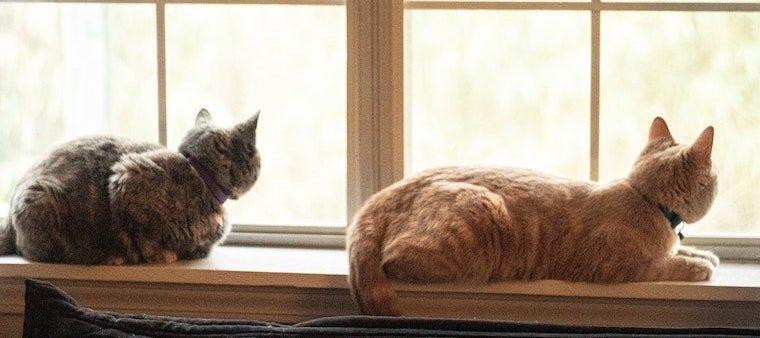In this two-part blog, Dr. Justine Lee, DACVECC, DABT, reviews all you need to know about Feline Leukemia (FeLV) in cats. She’ll discuss what FeLV is, how it’s transmitted, and what the clinical signs are. Please make sure to tune into Part 2 next month to find out how to prevent it, and what you need to know as a cat parent on keeping your cat(s) safe!
What’s the most important thing you need to know before you bring a new cat home?
In a previous blog, I talked about how to introduce new cats to each other. But first, I want you to stop by your veterinary clinic for a blood test—before your cats even meet or have physical contact!
That’s because there’s a highly contagious virus called feline leukemia (often called or abbreviated “FeLV”), and it’s really important to know your cat’s status for FeLV before you introduce cats to each other.
What shocks me as a veterinarian? I frequently ask cat parents if they know their cat’s FeLV or FIV status, and most assume their cat is negative but aren’t sure. While veterinarians often test for this, this is a test result you MUST know for your cat’s sake (I compare it to not knowing your partner’s HIV status). That’s because the diagnosis of FeLV dramatically affects your cat’s lifespan… from living to be a healthy 15- to 20-year-old cat to just a 2- or 3-year old cat.
So, what exactly is feline leukemia (FeLV)?
Feline leukemia is caused by a highly contagious retrovirus and is one of the deadliest viruses for cats. (Decades ago, it was one of the viruses used to study human retroviruses, such as HIV/AIDS). Feline leukemia affects your cat’s bone marrow and immune system (e.g., the lymphoid organs like the lymph nodes, thymus, spleen). Once this virus affects your cat’s body, it can result in cell mutation, cancer (such as lymphoma), and direct effects on the number of white and red blood cells in your cat’s body. This can result in leukemia and severe bone marrow suppression (e.g., anemia, immune deficiency). As a result, your cat’s body is more susceptible to infections, parasites, inflammatory problems, and whole-body (or “systemic”) effects.
As a veterinarian, I’ve had to break the news to cat parents that their cat has this deadly disease—and it’s so heartbreaking because FeLV has a really poor prognosis. Unfortunately, as a veterinary specialist, by the time I diagnose or see a cat with FeLV, it’s often too late. The signs are really severe and the disease has already ravished the body; sadly, pet parents only get a few days to weeks with their cat during the end stages of FeLV when I break the bad news. That’s why FeLV is one of my most hated diseases to diagnose as a veterinarian.
How common is FeLV?
Thankfully, I don’t see FeLV every single day. In fact, thanks to vaccination, testing, and pet parent education, I see this deadly feline virus less commonly than when I first started practicing (20+ years ago!). That said, it’s still estimated that 1-3% of cats in the United States are infected with FeLV. However, infection rates for FeLV go up dramatically (up to 30%) in ill or at-risk cats.
Which cats are at increased risk for FeLV?
Some cats are more at risk for FeLV: male cats and those that have outdoor access. Clinically, I also see kittens at higher risk for FeLV, as their immune system is weaker and more immature (due to their age). Kittens may have innocently gotten the infection from their mother.
What about cats that are less at risk for FeLV? Cats that live indoors and that are neutered or spayed are at less risk for FeLV. And those that are vaccinated for FeLV are at less risk! Next month, tune in for Part 2 to find out specific things you can do to prevent FeLV in your cats, and what you can do to keep your cats safe.
How do cats get FeLV? How is FeLV spread?
Unfortunately, feline leukemia is very contagious to other cats—especially from bite wounds or prolonged close contact to a FeLV+ cat. Cats get FeLV predominantly through bodily fluids such as saliva, milk, respiratory or nasal secretions, placental transfer, urine, blood, and, rarely, feces. Sources of exposure to FeLV include:
- Bite wounds (from exposure outdoors and fighting)
- Grooming each other
- Placental transfer
- Nursing
- Sexual transmission
- Using the same water and food bowls (less common)
- Using the same litter boxes (less common)
- Blood transfusions (rare)
Can I get FeLV from my cat?
While humans get retroviruses, FeLV is a feline-specific disease—so it cannot spread to humans.
What are the signs of FeLV in cats?
Depending on where FeLV is affecting the body, signs of feline leukemia in cats may include:
- Weakness
- Exercise intolerance
- Decreased appetite
- Weight loss
- Unkempt appearance or haircoat
- Fever
- Hypothermia (with severe symptoms, especially with anemia)
- Pale gums (e.g., anemia)
- Difficulty breathing
- Abnormal fluid in the chest cavity (e.g., pleural effusion)
- Tumors in the chest cavity (e.g., mediastinal tumors)
- Gastrointestinal signs (e.g., diarrhea)
- Ocular changes (e.g., inflammation of the eye)
- Generalized infections or inflammation in the body
- Enlarged lymph nodes
- Miscarriage or fetal death
- Death
How do you diagnose FeLV in cats?
As a veterinarian and cat parent, testing for FeLV/FIV is a MUST DO before your new cat steps one paw into your household. Why? Again, because this virus is so infectious—and I don’t want to expose any other house cats to it.
All cats should be tested for FeLV and all cat parents should know their cat’s results!
Your veterinarian will want to test your cat (or kitten) for this on your cat’s first veterinary visit. (If they don’t, look elsewhere!) Depending on your cat’s lifestyle, this test may need to be repeated annually (if your cat goes outside). The test for FeLV is a simple blood test. Please note that there are several types of blood tests, including the ELISA, IFA, and PCR. (There are also less common saliva and tear tests for FeLV, but these are not as accurate and are not recommended).
ELISA test
The most common blood test for FeLV is the ELISA test, which is readily available at any veterinary clinic or animal shelter. This test is very accurate and inexpensive to run, and you can get results back within minutes. (This blood test is typically in combination with the FIV or even feline heartworm test.) The FeLV portion tests for the presence of the virus (called p27) or its antigens (not antibodies, like the FIV test).
Please know that some animal shelters and breeders may test, but not all do. So, you always, always, always want to test (or re-test) your new cat as soon as you obtain them! If you just got a kitten, I often repeat the blood test a few weeks to months later for confirmation (around 6 months of age).
Next steps
If your cat tests negative for FeLV, that’s great news—a negative test is very reliable. However, if your cat was recently infected or exposed (e.g., after sneaking outside and getting into a cat fight), your cat should be re-tested at least 1-2 months after exposure.
If your kitten or cat tests positive for FeLV, your veterinarian will need to send out different blood tests—the IFA or PCR—to confirm the diagnosis. These are more specific tests that test for specific parts of the FeLV retrovirus or more advanced disease. (You should also keep your cat indoors only and isolated from other feline housemates until additional testing is confirmed.)
Please note that a cat shouldn’t be euthanized based solely on the initial diagnosis of FeLV, as no test is 100% accurate. We veterinarians need to interpret the test results based on your cat’s health, likelihood of infection, your cat’s ability to fight off the infection, persistent viremia, and confirmation of other tests! Some cats can seroconvert and go from a positive FeLV test to a negative test, so we need to re-test carefully, appropriately, and repeatedly.
My general rule
In the veterinary ER, the FeLV test is one of the first diagnostic blood tests that I run on a sick cat... especially if they are a younger, male, indoor/outdoor cat that occasionally scraps with other cats. Since the prognosis for feline leukemia is so poor, the FeLV is considered a “must-do” screening test. Plus, we know that infection rates for FeLV go up to 30% in ill or at-risk cats! Before I spend a pet parent’s money (which can add up to thousands of dollars in the veterinary ER) trying to save a cat, I beg of you: Make sure your cat has been tested for FeLV.
For me? My general rule is that any cat that you adopt, purchase, or rescue should always be tested for both FeLV and FIV before you even let them see your other cats. This is so important to keep your other cats safe and minimize disease spread. While it seems extreme, it really is for the sake of your other cats’ health!
When in doubt, talk to your veterinarian about feline leukemia, as you want to make sure to keep your cat(s) safe. Learn more with some great information from the Cornell Feline Health Center and the American Association of Feline Practitioners.
Make sure to tune into Part 2 next month. I’ll discuss more about how to prevent FeLV, and what you need to know as a cat parent on keeping your cat(s) safe from this contagious virus!





